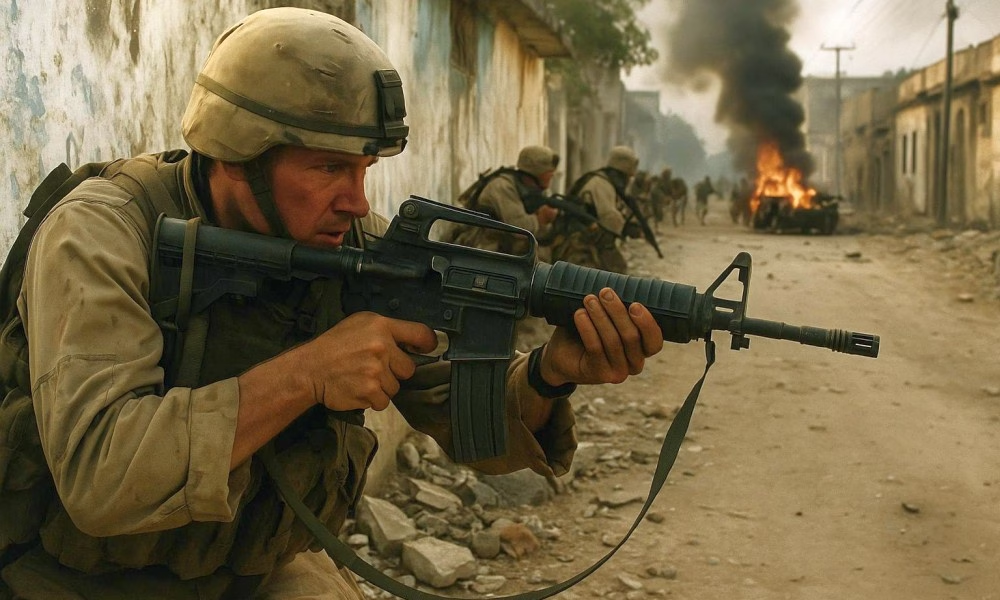
By Mike Moad
On October 3–4, 1993, American forces fought one of the fiercest urban battles since the Vietnam War. Known as the Battle of Mogadishu, it began as a raid to capture Somali warlord lieutenants and ended as an 18-hour firefight that would shape U.S. military policy and doctrine for decades. Immortalized in Mark Bowden’s Black Hawk Down and the 2001 film adaptation, the battle remains a defining chapter in the story of modern warfare.
Background: Somalia in Crisis
By the early 1990s, Somalia was collapsing into civil war. Warlords carved up Mogadishu, diverting international food aid intended for millions of starving citizens. The most powerful among them, Mohamed Farrah Aidid, regularly attacked United Nations peacekeepers and humanitarian workers.
The United States, initially present for famine relief, expanded its role to include capturing Aidid and neutralizing his militia. By mid-1993, a specialized U.S. task force was deployed under the command of Major General William F. Garrison with one mission: dismantle Aidid’s command network.
Task Force Ranger: America’s Elite
The unit assigned to this dangerous mission was Task Force Ranger, a joint special operations force composed of:
- Delta Force operators (1st SFOD-D) – America’s premier counterterrorism unit.
- 75th Ranger Regiment (3rd Battalion) – elite infantry skilled in airborne and urban operations.
- 160th Special Operations Aviation Regiment (Night Stalkers) – helicopter pilots specializing in night and precision flying.
- Navy SEALs (Team 6 operators) and Air Force Pararescue Combat Controllers – providing additional capability.
Together, these units represented the tip of the spear of U.S. military capability.
The Raid and Timeline of Events
October 3, 1993, 15:42 – Task Force Ranger launched from their base to capture two of Aidid’s top lieutenants meeting at a building in central Mogadishu. Rangers fast-roped into the city while Delta operators stormed the target building.
Within Minutes – The targets were captured successfully, but Somali militia quickly mobilized. Swarms of armed fighters and civilians armed with AK-47s and RPGs converged on the area.
16:20 – A UH-60 Black Hawk helicopter, call sign Super 61, was hit by an RPG and crashed several blocks from the raid site. U.S. forces diverted to secure the crash.
Moments Later – Another Black Hawk, Super 64, was shot down, creating a second crash site deep inside hostile territory.
Nightfall – American soldiers were surrounded by thousands of Somali fighters. Small squads fought block by block, defending crash sites and rescuing fellow soldiers under constant fire.
October 4, 05:30 – After nearly 18 hours of combat, U.S. forces were extracted with the aid of Pakistani and Malaysian armored vehicles under U.N. command. Survivors were exhausted, bloodied, and forever changed.
Casualties and Losses
- U.S. Forces: 18 killed, 73 wounded.
- Somali Militia & Civilians: Estimates vary widely, ranging from 300 to over 1,000 killed.
The haunting images of an American soldier’s body dragged through Mogadishu’s streets stunned the American public and shifted national opinion.
Acts of Heroism
Among the many acts of valor, two stand out. Master Sergeant Gary Gordon and Sergeant First Class Randy Shughart, Delta Force snipers, volunteered to protect downed pilot Michael Durant. Fighting against overwhelming numbers, they defended him until they were killed. Both were posthumously awarded the Medal of Honor.
Legacy of the Battle
The Battle of Mogadishu had far-reaching effects:
- Military Doctrine: It underscored the need for armored support in urban combat and influenced how U.S. forces prepared for asymmetric warfare.
- Foreign Policy: The loss of 18 Americans led to a withdrawal from Somalia and increased caution in future humanitarian interventions, particularly in Rwanda the following year.
- Cultural Impact: Through Black Hawk Down, the battle entered public memory, shaping how Americans viewed modern war and the risks of intervention.
Honoring the Fallen
- The Mogadishu Mile: At the end of the battle, Rangers and Delta operators were forced to move on foot through hostile streets to reach safety. Today, the “Mogadishu Mile” is run by service members and veterans to honor the courage of those who fought.
- Books & Films: Mark Bowden’s Black Hawk Down and Ridley Scott’s film adaptation captured the chaos, bravery, and tragedy of the battle. Numerous memoirs from veterans provide firsthand accounts of endurance and sacrifice.
Conclusion
The Battle of Mogadishu stands as one of the most intense urban firefights in American history. It is remembered not only for its tactical lessons but also for the extraordinary valor of the men who fought against overwhelming odds. Thirty-two years later, the legacy of their courage endures in every Mogadishu Mile run, every commemoration, and in the lessons that continue to shape U.S. military operations around the world.




